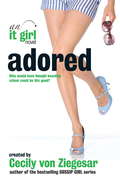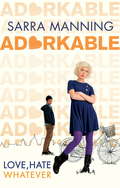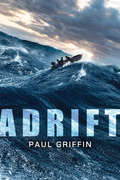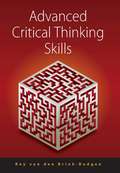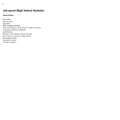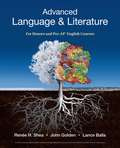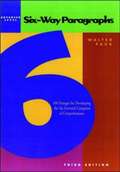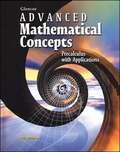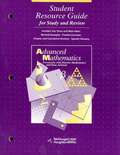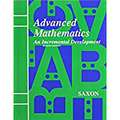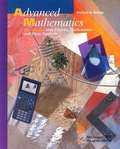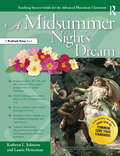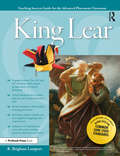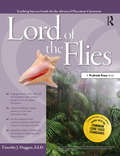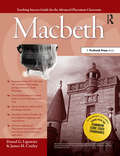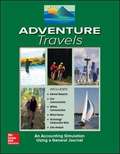- Table View
- List View
Adored (It Girl #8)
by Cecily Von ZiegesarBrett Messerchmidt is planning Waverly Academy's annual holiday ball and gift exchange. But when some enterprising students decide that playing Secret Satan is infinitely more fun, the entire school starts acting naughty. Now all Brett wants for Christmas is a quiet holiday--and a kiss from a certain someone under the mistletoe. Too bad Callie Vernon has the same idea. Ho ho no! Everybody at Waverly is getting into the giving spirit. The only present Tinsley Carmichael wants to unwrap this holiday is her new boyfriend, Julian McCafferty. But what happens when she uncovers a shady secret from his past instead? Santa knows when you've been bad or good ... but what's the point of being good when being bad is so much fun?
Adored: An It Girl Novel
by Cecily Von ZiegesarJenny Humphrey's time at Waverly Academy has had its ups and downs - from making enemies of the most popular girl at school to stealing her room mate's boyfriend. But now everything has changed - Jenny, Tinsley, Callie and Brett have put their differences behind them to jointly rule over Waverly Academy - but how long can peace last?
Adorkable
by Sarra ManningJeane Smith's a blogger, a dreamer, a dare-to-dreamer, jumble sale queen, CEO of her own lifestyle brand and has half a million followers on Twitter.Michael Lee's a star of school, stage and playing field. A golden boy in a Jack Wills hoodie.They have nothing in common but a pair of cheating exes. So why can't they stop snogging?
Adrenaline High
by C. A. ForsythD'Arcy is a 16-year-old overachiever and a budding newshound. When her classmate Zania's mother goes missing, D'Arcy thinks she's found the mother of all scoops. She's determined to solve the mystery and capture it all on film. But Zania's troubles are no game. She suspects her mother's drug-dealing boyfriend may be behind her sudden disappearance and Zania's too scared to go home. It's not long before the girls realize that they're in over their heads. Adrenalin High is a gripping, fast-paced story for mystery lovers.
Adrift
by Paul GriffinFrom critically acclaimed writer Paul Griffin comes a fast-paced young adult novel about five very different teens lost at sea with no one to count on but each other.Matt and John are best friends working out in Montauk for the summer. When Driana, JoJo and Stef invite the boys to their Hamptons mansion, Matt and John find themselves in a sticky situation where temptation rivals sensibility. The newfound friends head out into the Atlantic after midnight in a stolen boat. None of them come back whole, and not all of them come back.Worlds collide when the group ventures out to sea aboard an antique ship that Stef sneaks out from her dad's dock. As the waves rise and the fragile vessel weakens, things go horribly wrong. Adrift at sea for days, who will have what it takes to survive?
Advanced Adobe Photoshop CS5 Revealed
by Chris BotelloDiscover all that Photoshop CS5 has to offer with ADVANCED ADOBE PHOTOSHOP CS5 REVEALED. This book teaches advanced design techniques using one of the most popular photo-editing programs on the market. Using step-by-step tutorials, readers work with curves, levels, blending modes, painting and drawing tools, and the latest Photoshop special effects to create professional-quality designs and images. They are challenged not only as Photoshop users but as designers, following the steps a designer would take to complete real-world projects. They also see what works in a design and what doesn't. Readers then take their craft to the next level by using the advanced end-of-chapter learning projects. The book's full-color interior and highly visual design make this the ideal book for learning advanced design techniques using the latest version of Adobe Photoshop.
Advanced Chemistry in Creation (2nd Edition)
by Jay L. WileYou are about to embark upon an amazing journey! In this text, you will take a deep look at the fascinating subject of chemistry. You will learn about the matter that makes up God's creation and how it changes. Although this course will be hard work, you will learn some truly incredible things.
Advanced Critical Thinking Skills
by Roy Van Den Brink-BudgenThis book takes the skills introduced in Roy van den Brink-Budgen's bestselling book Critical Thinking for Students and extends and builds on them. As a result, it will be especially useful for students on advanced level courses, whether in schools, colleges, or universities. It shows how complex arguments can be built up, analysed, and evaluated. It also shows how the use of various types of claim can be approached in argument, by stressing the need to ask a series of questions about their possible significance. The frequent role of explanation in the drawing of inference is also detailed. In addition, it applies Critical Thinking skills to decision-making, showing how these skills can clarify the choices available, their possible consequences, and the criteria needed to make decisions. In short, this book shows how to become an even more active and effective Critical Thinker.
Advanced High School Statistics
by David DiezThe OpenIntro project was founded in 2009 to improve the quality and availability of education by producing exceptional books and teaching tools that are free to use and easy to modify. We feature real data whenever possible, and files for the entire textbook are freely available at openintro.org. The future for OpenIntro depends on the involvement and enthusiasm of our community. Visit our website, openintro.org. We provide free videos, statistical software labs, lecture slides, course management tools, and many other helpful resources. This textbook is also available for $20. However, we offer this $25 retail price version to hit the minimum for free shipping on some platforms.
Advanced Language & Literature for Honors and Pre-AP English Courses
by Renée H. Shea John Golden Lance BallaAP® teachers know the roots of AP® success are established in the earlier grades. That is the idea behind Advanced Language & Literature—a complete solution for 10th grade honors and Pre-AP® English classes. Driven by the expertise of Renee Shea, John Golden, and Lance Balla, this introduction to literature and nonfiction, reading and writing, analysis and argument, is both challenging and nurturing; a book full of big ideas, thought-provoking texts, and all of the support young minds need to be prepared for AP® success. *Pre-AP is a trademark registered and/or owned by the College Board, which was not involved in the production of and does not endorse this product.
Advanced Level: Six-Way Paragraphs
by Walter PaukSix-Way Paragraphs, a three-level series, teaches the basic skills necessary for reading factual material through the use of the following six types of questions: subject matter, main idea, supporting details, conclusions, clarifying devices, and vocabulary in context.
Advanced Mathematical Concepts: Precalculus with Applications
by Berchie Holliday Gilbert J. Cuevas John A. Carter Melissa S. Mcclure Daniel MarksLearn about relations, functions, graphs, trigonometry, discrete mathematics and calculus in this book.
Advanced Mathematical Concepts: Precalculus with Applications
by Glencoe StaffPrecalculus textbook, covering topics from graphing, to trigonometry, to conic sections, to the surface of calculus
Advanced Mathematics Precalculus With Discrete Mathematics And Data Analysis
by Houghton Mifflin Company StaffThe Student Resource Guide for Study and Review is a set of lessons designed to help students study and review effectively. This guide is intended to be used in conjunction with Advanced Mathematics, Precalculus with Discrete Mathematics and Data Analysis.
Advanced Mathematics: Precalculus with Discrete Mathematics and Data Analysis
by Richard G. BrownNIMAC-sourced textbook
Advanced Mathematics: Precalculus with Discrete Mathematics and Data Analysis
by Richard G. BrownMath textbook for high school students
Advanced Placement Classroom: A Midsummer Night's Dream (Teaching Success Guides For The Advanced Placement Classroom Ser. #0)
by Kathryn L. Johnson Laurie HeinemannAdvanced Placement Classroom: A Midsummer Night's Dream takes students inside Shakespeare's well-loved comedy by providing teachers and students with a detailed overview of the play, along with interesting and challenging activities geared for the advanced language arts student. Students will examine Shakespeare's inventive language by collecting words and phrases to use later in a “Sweet-Talk Challenge,” akin to a modern-day poetry slam; discover the history behind the play by researching and giving presentations on Elizabethan occupations; and recognize the challenge of performance by reenacting scenes.Prufrock's new line of innovative teaching guides for the Advanced Placement classroom is designed to engage students with creative learning activities that ensure Advanced Placement success. The Teaching Success Guide for the Advanced Placement Classroom series helps teachers motivate students above and beyond the norm by introducing investigative, hands-on activities including debates, role-plays, experiments, projects, and more, all based on Advanced Placement and college-level standards for learning.Grades 7-12
Advanced Placement Classroom: King Lear (Teaching Success Guides For The Advanced Placement Classroom Ser. #0)
by R. Brigham LambertThe Teaching Success Guide for the Advanced Placement Classroom series helps teachers motivate students above and beyond the norm by introducing investigative, hands-on activities, including debates, role-plays, experiments, projects, and more, all based on Advanced Placement and college-level standards for learning.King Lear is a user-friendly guide to teaching one of Shakespeare's classic plays and includes field-tested and proven methods for assigning daily interpretive readings, leading intriguing seminar discussions, and connecting the play to modern-day poetry and social media platforms, plus many more resources for enhancing the study of Shakespeare in Advanced Placement and pre-AP courses.Grades 7-12
Advanced Placement Classroom: Lord of the Flies (Teaching Success Guides For The Advanced Placement Classroom Ser. #0)
by Timothy J. DugganAdvanced Placement Classroom: Lord of the Flies takes a fresh approach to a school classic by offering an abundance of student-centered classroom ideas. A large menu of rigorous choices will engage both teachers and students in the process of building interpretations through close reading, collaboration, and active learning. Clearly explained prereading, reading, and post-reading tasks help students to develop their individual encounters with the text and then enter the conversation of literary scholars. Additional chapters explore the interface between the world of the text and the text in the world, including technology integration. Sample AP prompts and essay analyses are included. Grades 9-12
Advanced Placement Classroom: Macbeth (Teaching Success Guides For The Advanced Placement Classroom Ser. #0)
by James Conley Daniel G. LipowitzAdvanced Placement Classroom: Macbeth is a teacher-friendly resource for using one of Shakespeare's greatest tragedies in the Advanced Placement classroom. Students will examine the play critically and analytically to understand aspects such as the nature of villainy and the history of the events that inspired the play. An extended section provides teachers with information on societal implications that impacted the play's creation, including witchcraft and The Gunpowder Plot. Teachers also will be able to implement exciting hands-on projects such as putting Macbeth on trial for the murder of Banquo and developing a soundtrack for the play.Grades 7-12
Advanced Skills for Health Care Providers
by Barbara AcelloThis book was written to prepare the nursing assistant or patient care technician to provide advanced patient care procedures. The book includes content on sterile procedures, including preparing and working with a sterile field, using sterile technique, and performing sterile dressing changes, wet to dry dressings. Venipuncture technique is covered in several chapters as well as intravenous procedures and many other advanced skills. The importance of reporting information and observations to the licensed supervisor is emphasized throughout the book. To this end, most chapters contain special text boxes listing observations to be reported and recorded. Added highlights within the text narrative include safety and infection control alerts, and age related information; information that is important to the student and in keeping with the latest health care trends.
Advanced Word Power
by Beth Johnson Susan GamerYou can never know enough words. Every person you meet knows an extra word you would not be familiar with and he/ she as well. This book invites you to Advanced Word Power. It teaches 30 power words in the college vocabulary likely to be used in examinations and tests.
Adventure Travels: An Accounting Simulation Using a General Journal
by Glencoe Mcgraw-HillSimulation of an accountant working at a travel agency.

